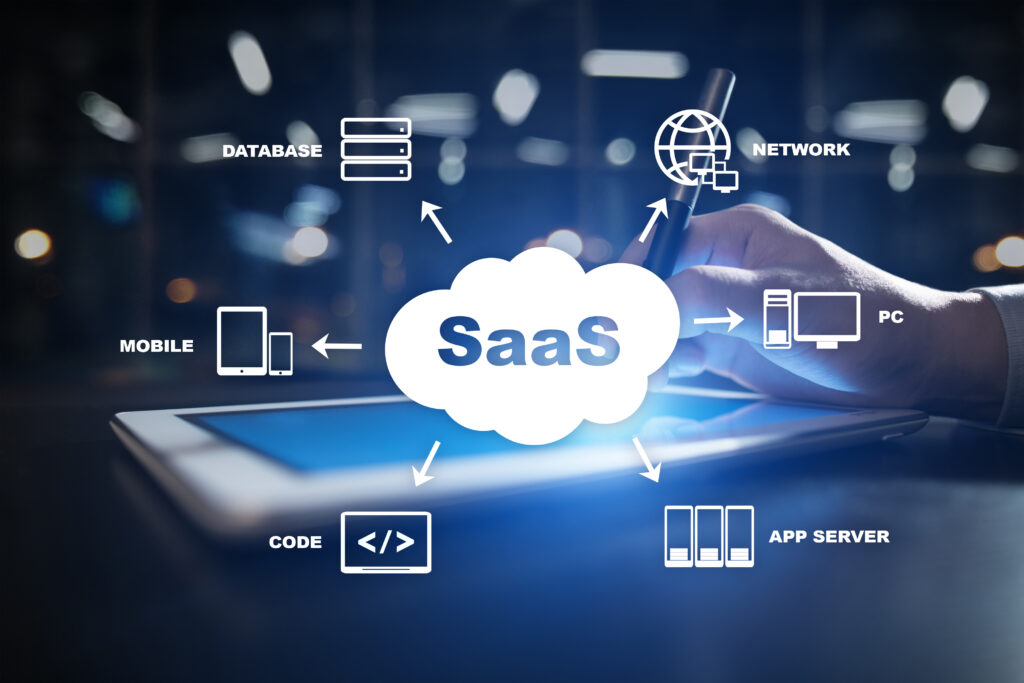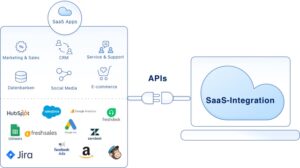SaaS Integrations – Definition and How it Helps Businesses

Software as a Service, or SaaS for short, is now the dominant technology in every company. Companies with more than 1000 employees usually use over 150 (!) different SaaS systems. Source
To ensure that the team keeps track of the variety of systems and still uses the many software applications efficiently, the systems can be integrated. In the following article we explain how it works, what challenges companies have to overcome and how they can benefit from successful SaaS integrations.
Content
1. What exactly is SaaS – common examples
SaaS, “Software as a Service” generally stands for a license model in which software applications are provided via a cloud. Licenses are rented on a monthly or annual subscription basis. There are no longer high acquisition costs and on top of it the software provider bears the expenses for all other services, such as maintenance and updates. Instead of storing the data on in-house data centers (on-premise), it will be with the provider in the cloud.
SaaS software examples
Companies use a wide variety of SaaS models to improve business processes or to facilitate collaboration between teams and employees.
Specific SaaS systems may include:
- Project Management Tools: Trello, Asana, MS Project
- CRM: Salesforce, Hubspot
- ERP: SAP ERP, Oracle ERP, Microsoft Dynamics ERP
- HRM: Personio, Recruitee, Sage
- Messaging Services: Slack, Google Hangouts etc.
2. The difference between SaaS and iPaaS
iPaaS (integration Platform as a Service) and SaaS all belong to the category of cloud computing services, also known as XaaS (Anything as a Service). They are each offered via remote access by an external service provider.
But what exactly is the difference between iPaaS and SaaS?
2.1 iPaaS
iPaaS stands for “Integration Platform as a Service” and links various applications into a single database.
iPaaS in itself is very similar to SaaS. The only minor difference is that with iPaaS, the provider provides a platform and offers it to the user as an integrated solution or service. Learn more about iPaaS.
2.3 SaaS
With Software as a Service (SaaS), unlike iPaaS, the provider delivers the application via a web browser. The simplest example is an email account with a web-based service such as Google Mail, where you can check your e-mails from any device.
3. How do SaaS integrations work?
A SaaS integration connects the individual applications to each other so that they are able to automatically exchange the relevant data and information and thus “talk” to each other. SaaS software can be connected to other SaaS applications as well as to local software programs.
The integrations are accomplished with the usage of interfaces, the so-called APIs (Application Programming Interfaces). These APIs or connectors are typically provided by the software vendor.
n order to keep track of the many systems, without integration this data would have to be transferred by hand if necessary, which is very error-prone and time-consuming.

Example:
A company uses Zendesk for its ticket management. Every time a customer request comes in, the relevant employee has to update the request both in Zendesk and in the respective CRM system. After a successful integration, the customer request is automatically updated in both systems. The employee can, for example, concentrate directly on the customer and the probability of errors decreases.
Too many apps not talking to each other?
Locoia integrates your apps & systems in one
unified data warehouse
4. Benefits of SaaS integrations
So how can companies benefit of SaaS integrations?
4.1. Transparency
By integrating the SaaS software, the team can now access all the relevant information with just one application. This eliminates tedious processes such as checking different systems or querying colleagues. As a result, employees can concentrate on their core activities without being distracted by colleagues with bothersome data queries.
Example: Has the customer renewed his subscription? Which products did the customer order from which department in the past?
4.2 Saving time
Because employees no longer have to spend time searching for individual data or waiting for colleagues to respond, they save themselves a massive amount of time. This valuable time can be used for more strategically important tasks, such as achieving company goals.
Example: A startup wants to integrate their online store on Shopify with a CRM like Salesforce. After the integration, the transactions no longer need to be updated in both systems.
Without integration, each purchase may be manually emailed to the appropriate department for booking and execution. This email will be sent automatically after integration.
4.3. Better employee and customer experience
Employees are relieved of tedious manual work so they can focus on more challenging and strategic work. Or you can spend more time with your customers. More fun at work and higher satisfaction are the result, both on the part of employees and customers.
5. Challenges with SaaS integrations
As valuable as these benefits are for sustainable growth for companies, there are certain integration challenges, that need to be considered.
5.1. Technical expertise required
Since a high level of technical expertise is required, employees can rarely perform the integrations themselves. As a result, integration backlogs and data silos can occur, leading to much frustration within teams.
Solution:
To take full advantage of SaaS integrations, companies can deploy an automation platform. It will take over the integration completely, create external interfaces if necessary and often also offer the training for the teams in the form of tutorials.
Increase in efficiency through process automation
Locoia integrates your apps & systems in one
unified data warehouse
5.2. Lack of control and security issues
By using SaaS services, the user relinquishes part of his data control to the provider. Data security is no longer in the hands of the users’s own company.
Solution:
A suitable provider who can fully guarantee data protection must be found for the integration solution. In addition, it should regulate the flow of data and ensure the highest level of security for sensitive data and information.
5.3 Missing or incorrect connectors
SaaS providers often do not provide suitable interfaces. However, to be able to seamlessly integrate all applications flawlessly, companies need the corresponding connectors.
Solution:
The good integration software platforms, supply the right connectors and interfaces, or if necessary, create them individually on demand.
6. How companies can benefit from SaaS integrations
To take full advantage of the benefits of SaaS integration and avoid the drawbacks, companies should run the integration through an external third-party provider. The integration platforms or software usually offer the highest possible security standard for data. They also take care of the connectors and other challenges that an integration entails.
For companies with a myriad of SaaS apps, the initial focus is on integrating those that make the most economic sense and contribute the most to drive revenue. The faster a company is in reliable communication with customers and trading partners, the more opportunities it has in the market.
Whether some of the data is on-premise or already fully in the cloud, an integration specialist can help synchronize data streams. That way, companies can occupy a competitive position in the long term.
